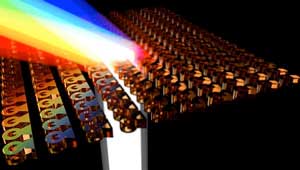| Posted: Feb 22, 2018 |
Flat-packed optical components
(Nanowerk News) Surfaces that efficiently redirect the propagation of light have been developed by A*STAR researchers. Ramón Paniagua-Domínguez, working with colleagues from the A*STAR Data Storage Institute and Nanyang Technological University, has invented compact and light-weight optical components that could be integrated into portable optoelectronic devices (Nano Letters, "Asymmetric nanoantennas for ultrahigh angle broadband visible light bending").
|
 |
| A metasurface with fish-like elements redirects an incoming beam of light into a new direction. (Image: A*STAR Data Storage Institute)
|
|
Traditional glass optical components alter the propagation of light through reflection and refraction. They tend to be three-dimensional: a lens, for example, requires a curved surface that focuses light to a point. But these bulky elements add weight, to mobile phone cameras for example.
|
|
Traditional glass optical components alter
A flatter alternative is found in metasurfaces, which consist of an array of structures, each smaller than the wavelength of light, engineered to modify the characteristics of incident light. As an optical beam hits this surface, it scatters off the subwavelength elements, forming an output beam with chosen properties. This can, for example, be used to bend the incoming beam into a new direction. However, the efficiency with which the light is redistributed into the correct direction decreases sharply for increasing angles, making bending light at very large angles difficult.
|
|
Traditional glass optical components alter
Paniagua-Domínguez and the team achieve efficient optical channeling at any desired angle using a metasurface comprising an array of asymmetric nanoantennas. Just like normal antennas, they alter the scattering directivity patterns by suppressing or enhancing emission at different angles. “Our new approach goes beyond the standard design, which is to use phase mapping,” explains Paniagua-Domínguez. “We foresee that these metasurfaces may out-perform traditional bulk optics not only in terms of efficiency, but also functionality.”
|
|
Traditional glass optical components alter
The researchers demonstrated this concept experimentally by etching their nanoantenna array design into a thin film of titanium dioxide on a glass substrate. One design they investigated had a structure that loosely resembled a fish, with a ring surrounding one vertex of a triangle. The dimensions of the fish were all below 300 nanometers, much smaller that the wavelength of the incident light. With this novel approach they were able to bend more than 50 per cent of the energy of an incoming beam of green light at an angle of up to 73 degrees. Moreover, and contrary to previous approaches, this structure demonstrated broadband operation, effectively bending light across wavelengths in the green and blue parts of the spectrum.
|
|
Traditional glass optical components alter
“Based on this concept, we are now working towards a flat lens with an extremely large numerical aperture,” says Paniagua-Domínguez. “That is, a lens that can focus light into a very small spot or resolve very small objects or features.”
|

